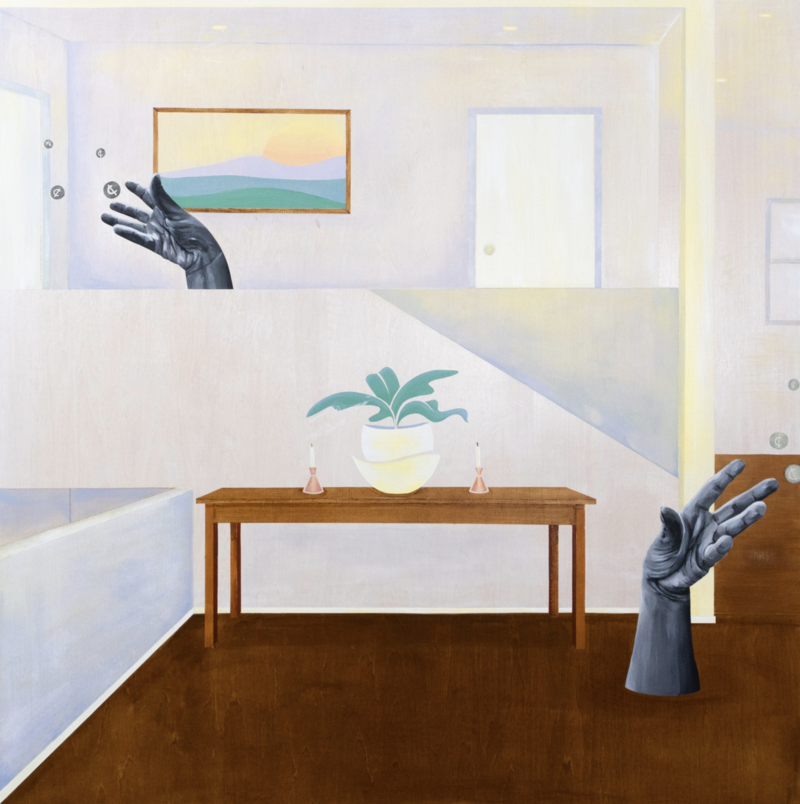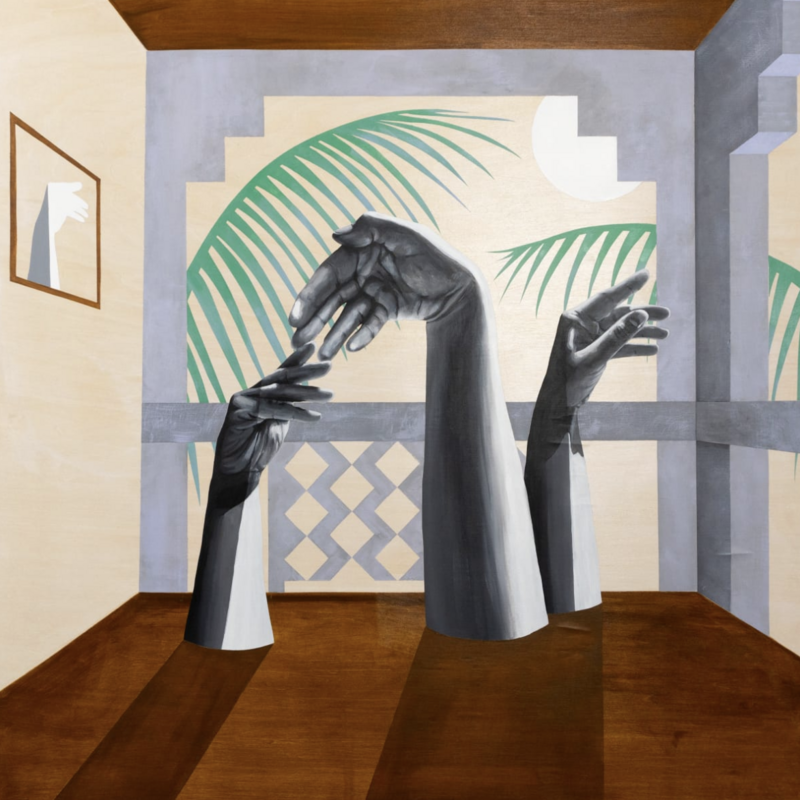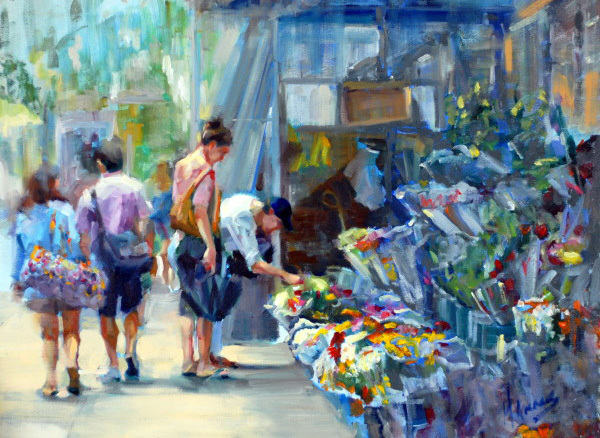April Werle is a narrative painter, whose works investigate how culture is internalized and negotiated as a mixed-race person.
Artwork Archive's Featured Artist April Werle paints tableaus of black-and-white hands acting out everyday, intimate scenes of her mixed Filipino American family.
Her autobiographical work narrates how culture is internalized and negotiated by mixed-race individuals and multicultural families through small, impactful moments.
With visual metaphors, Aprils sets her scenes—displacing hands from their roots, combining brown stain and whitewash, and perpetually "other-ing" her rendered characters from their simplified, colorful, and tactile environments.
Artwork Archive had the chance to chat with April Werle about her creative process, why she started exploring her mixed-race identity through her work, and how Artwork Archive helps her manage her art career.
You can see more of her work on Discovery and learn more about her art practice below:
April Werle—Secret Life of a Multicultural Couple- Exhibition Image. Photo courtesy of the artist
Can you walk us through your creative process?
I almost never create just one painting at a time. I prefer to work on paintings collectively and develop each body of work in two phases.
The first phase involves writing, researching, and documenting. In the first couple months of an 8-12 month period, I read a lot of fiction and memoirs by Filipino American authors, as well as investigative journalism like Brown by Kamal Al-Solaylee. During this time, I think critically about the theme and context of my last show to build upon them in the next. Simultaneously, I thumbnail moments from my own life and family to create a story arc for my upcoming paintings.
In the second phase, I follow a regimented painting process. First, I stain and prep all of my panels. Then, I painstakingly take photo references, mask, and paint the hands. Finally, I mask and paint all of the backgrounds.
I know a piece is done when I don’t feel FOMO over adding an extra element.
Usually, I sit back in my peacock chair, and when I get emotional about a piece, I know it’s a good one.
Can you describe the moment or experience that inspired you to start exploring themes of mixed-race identity and cultural heritage in your work?
I first started creating work about being mixed-race after a semester abroad in Malaysia. I had chosen Malaysia because of its proximity to the Philippines, and my school didn’t have an exchange program there.
During my time in Malaysia and the Philippines, I noticed the drastic difference in how I was treated compared to the United States.
This experience made me think a lot more about what being mixed means and inspired me to use my practice to explore themes of culture, race, and colorism.
When I came back to Montana to finish my BFA, the difficult critiques led me to abandon these themes after graduating. In 2020, when conversations about race and culture suddenly became more prevalent where I live, I began making work about my heritage again.
Soon after, I started receiving messages from friends, family, and strangers on how much it meant to see another mixed or second-generation FilAm creating work about shared experiences. These heartfelt messages encouraged me to continue on the subject.
April Werle, You Have to Eat Vegetables! 24 x 24 in, 2024
What drew you to focus on hands as a primary element in conveying body language and emotion?
When I began using hands as characters in my work, my goal was to make the characters more relatable. I wanted to limit the information I gave the viewer to reduce personal biases when interpreting my scenes. A face can bring so much information with it, and so can a body.
Additionally, you likely experience the world with your hands emoting in your peripheral vision, especially if you use your hands to emphasize verbal communication.
Hands are a form of language and can be easily understood cross-culturally.
We use our hands to directly connect with others and our environments, which is exactly what the characters in my work are doing.
What do you hope viewers take away from your work?
I want viewers to see a family, whether it resembles their own or perhaps their neighbor's.
By examining these relationships—whether through one mixed-race character learning to balance their relationship with themselves, a romantic duo learning to balance their cultures together, or a family of three passing down culture generationally—my hope is to broaden the viewer’s idea of what a family looks like and to shed light on the familial dynamics in a multicultural home.
My hope is to broaden the viewer’s idea of what a family looks like and to shed light on the familial dynamics in a multicultural home.
April Werle, Hide These For the Spirits, 36 x 36 in., 2023
In hindsight, what’s something you wish you knew before becoming a professional artist?
I wish I had known how much technical and critical writing would be a part of my practice.
I spend about 60 to 70% of my time writing about my work, specifically in applications, proposals, and presentations.
If I had known how much writing was involved in my visual art career, I would have taken art history more seriously and taken more writing classes.
Books that have been very helpful post-graduation include The Artist’s Guide to Grant Writing by Gigi Rosenberg, A Short Guide to Writing About Art by Sylvan Barnet, and The Artist’s Guide: How to Make a Living Doing What You Love by Jackie Battenfield.
Do you have any rituals or routines to get you in the creative headspace? Anything that you do in your studio before you start creating to enhance productivity, flow, and inspiration?
I typically start my mornings off by reading a few pages from a book, either on art or related to the themes in my work.
I also listen to podcasts or TV shows while I work. The theme of the podcast or TV show completely depends on what I need that day. If I'm looking for motivation, I listen to podcasts about art. If I'm looking to reduce stress and help me meet a deadline, I put on a sitcom.
While finishing my solo show in 2023, I binged all 11 seasons of Modern Family. More recently, while completing my solo show this spring, I watched all 18 seasons of Sister Wives.
Looking back, it seems that "alternative” family structures are a common theme here.
April Werle, I Belong to My Family, 36 x 36 in., 2023
Can you tell us why you decided on Artwork Archive to help manage your art career?
When I first realized I needed to document my work, it was because I needed information on a painting I had sold and couldn’t remember the exact dimensions. I started a spreadsheet with links to images and folders, but it quickly became convoluted.
I found that Artwork Archive is a streamlined way to keep records of my paintings and upload high-quality images without taking up space on my hard drive.
What a cloud-based system means:
With Artwork Archive, your data is securely stored on protected servers and accessible through the internet from any device.
This means you can manage your art business from anywhere, with the peace of mind that your data is secure and always backed up.
Learn more about what it means to be cloud-based here.
How do you use Artwork Archive on a daily basis?
Most recently, I’ve expanded my use of the platform by utilizing the Private Rooms feature.
For collectors inquiring about my work, I use Private Rooms to create a list of works specifically geared to them.
I think it adds a personal touch to create a room with their name on it and a password so they know it’s just for them.
They can also personalize it with the 'favorite' feature. Additionally, I use the Private Rooms feature to provide information to my gallery. The room includes the works they represent, and I use the description space to share my bio and statement.
What are Private Rooms?
Private Rooms allow you to create secure, personalized online viewing rooms for your clients or potential clients. These virtual rooms can be customized to showcase specific artworks, collections, projects, and details.
By providing a unique link (and the option to password-protect), you can grant exclusive access to your Private Rooms, making it easy to share and present your work in a professional way.
We've seen artists use Private Rooms for private showings, virtual exhibitions, showcasing a studio sale, or previewing new pieces before a public release!
Learn more about how to create Private Rooms here.
April Werle, Does This Bother You? 24 x 24 in, 2024
What advice would you give an artist who’s just starting out in their professional career?
My biggest piece of advice is to figure out who your audience is. Until you do, you may be making work just for yourself.
I believe we have a responsibility as artists to be thoughtful in the work we create.
We turn to the arts to learn about what it means to be human and to make sense of human experiences. Therefore, what you say through your work can have a significant impact on someone’s life.
Being mindful of who is most impacted by your work can also help grow your art career.
If you aren’t sure who your core audience is, start with yourself. Some questions you can ask yourself are:
- What are you interested in?
- Where did you grow up?
- What generation were you born in?
- What are important values to you and your family/friends?
Understanding your audience and the themes you both care about is how you align with art directors, curators, and collectors.
April Werle uses Artwork Archive to organize her artwork, send Private Rooms to her collectors, and a whole lot more.
You can make an online portfolio, catalog your artwork, and generate reports like inventory reports, tear sheets, and invoices in seconds with Artwork Archive. Take a look at Artwork Archive's free trial and start growing your art business.


.png)
.png)





63be.png)
_(7)b228.png)


